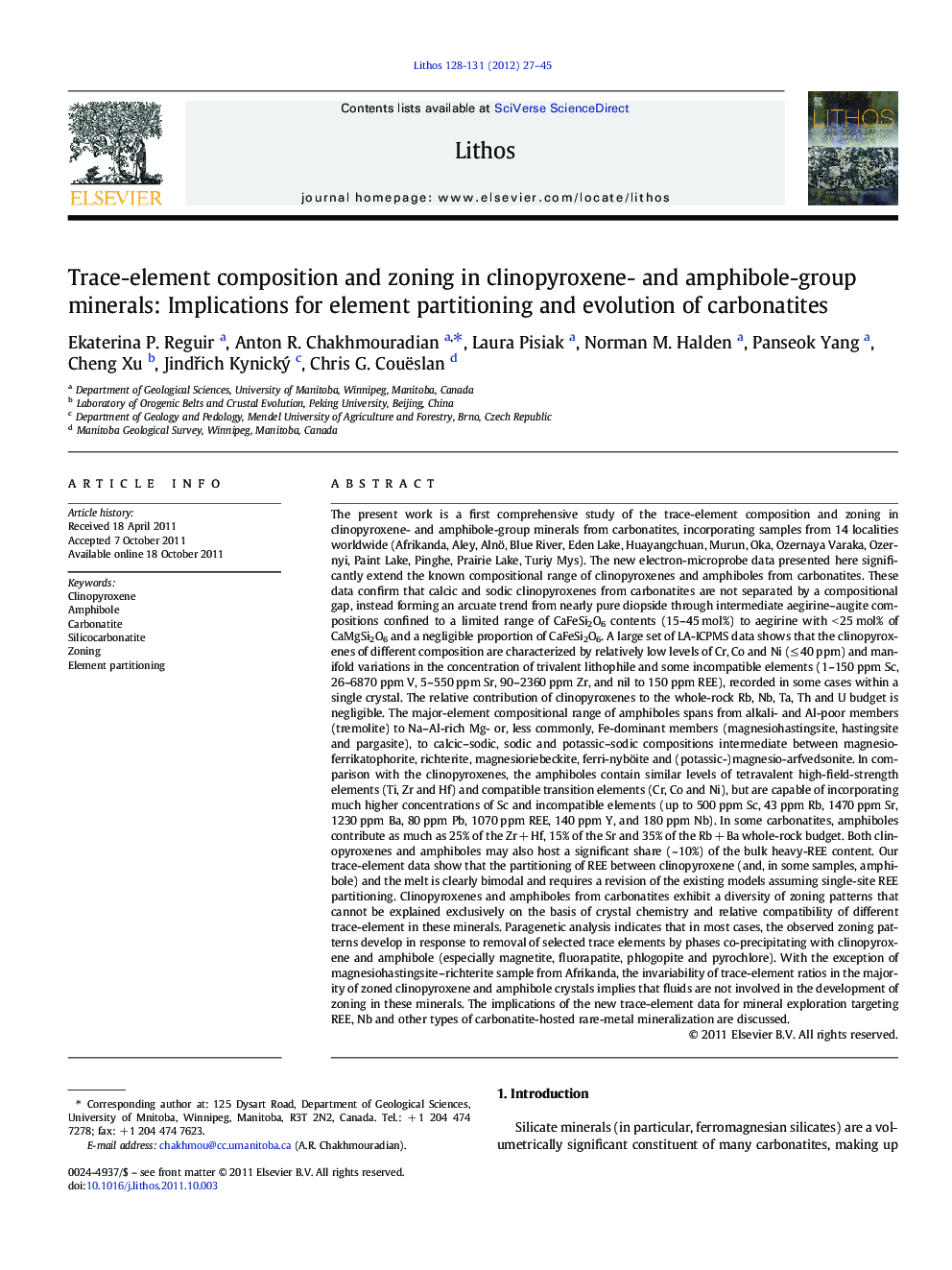| کد مقاله | کد نشریه | سال انتشار | مقاله انگلیسی | نسخه تمام متن |
|---|---|---|---|---|
| 4716678 | 1638713 | 2012 | 19 صفحه PDF | دانلود رایگان |

The present work is a first comprehensive study of the trace-element composition and zoning in clinopyroxene- and amphibole-group minerals from carbonatites, incorporating samples from 14 localities worldwide (Afrikanda, Aley, Alnö, Blue River, Eden Lake, Huayangchuan, Murun, Oka, Ozernaya Varaka, Ozernyi, Paint Lake, Pinghe, Prairie Lake, Turiy Mys). The new electron-microprobe data presented here significantly extend the known compositional range of clinopyroxenes and amphiboles from carbonatites. These data confirm that calcic and sodic clinopyroxenes from carbonatites are not separated by a compositional gap, instead forming an arcuate trend from nearly pure diopside through intermediate aegirine–augite compositions confined to a limited range of CaFeSi2O6 contents (15–45 mol%) to aegirine with < 25 mol% of CaMgSi2O6 and a negligible proportion of CaFeSi2O6. A large set of LA-ICPMS data shows that the clinopyroxenes of different composition are characterized by relatively low levels of Cr, Co and Ni (≤ 40 ppm) and manifold variations in the concentration of trivalent lithophile and some incompatible elements (1–150 ppm Sc, 26–6870 ppm V, 5–550 ppm Sr, 90–2360 ppm Zr, and nil to 150 ppm REE), recorded in some cases within a single crystal. The relative contribution of clinopyroxenes to the whole-rock Rb, Nb, Ta, Th and U budget is negligible. The major-element compositional range of amphiboles spans from alkali- and Al-poor members (tremolite) to Na–Al-rich Mg- or, less commonly, Fe-dominant members (magnesiohastingsite, hastingsite and pargasite), to calcic–sodic, sodic and potassic–sodic compositions intermediate between magnesio-ferrikatophorite, richterite, magnesioriebeckite, ferri-nyböite and (potassic-)magnesio-arfvedsonite. In comparison with the clinopyroxenes, the amphiboles contain similar levels of tetravalent high-field-strength elements (Ti, Zr and Hf) and compatible transition elements (Cr, Co and Ni), but are capable of incorporating much higher concentrations of Sc and incompatible elements (up to 500 ppm Sc, 43 ppm Rb, 1470 ppm Sr, 1230 ppm Ba, 80 ppm Pb, 1070 ppm REE, 140 ppm Y, and 180 ppm Nb). In some carbonatites, amphiboles contribute as much as 25% of the Zr + Hf, 15% of the Sr and 35% of the Rb + Ba whole-rock budget. Both clinopyroxenes and amphiboles may also host a significant share (~ 10%) of the bulk heavy-REE content. Our trace-element data show that the partitioning of REE between clinopyroxene (and, in some samples, amphibole) and the melt is clearly bimodal and requires a revision of the existing models assuming single-site REE partitioning. Clinopyroxenes and amphiboles from carbonatites exhibit a diversity of zoning patterns that cannot be explained exclusively on the basis of crystal chemistry and relative compatibility of different trace-element in these minerals. Paragenetic analysis indicates that in most cases, the observed zoning patterns develop in response to removal of selected trace elements by phases co-precipitating with clinopyroxene and amphibole (especially magnetite, fluorapatite, phlogopite and pyrochlore). With the exception of magnesiohastingsite–richterite sample from Afrikanda, the invariability of trace-element ratios in the majority of zoned clinopyroxene and amphibole crystals implies that fluids are not involved in the development of zoning in these minerals. The implications of the new trace-element data for mineral exploration targeting REE, Nb and other types of carbonatite-hosted rare-metal mineralization are discussed.
► Clinopyroxenes and amphiboles are important trace-element hosts in carbonatites.
► Amphiboles contribute a significant share of the bulk-rock Zr, Rb, Ba and REE budget.
► REE exhibit bimodal partitioning.
► Competitive partitioning controls zoning in clinopyroxenes and amphiboles.
Journal: Lithos - Volumes 128–131, January 2012, Pages 27–45